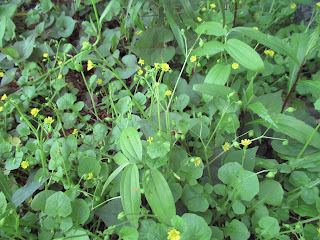Continuing last week’s theme, this week I tell you my adventure in cooking with leaves. This time, the green comes from a garden (alas, not forest) of my family. They are of Yuzu. It’s a sort of ubiquitous garden tree, at least in Yokohama. Our tree is not large, but bears lots of yellow fruits every winter。Our family makes jam, juice, etc. with them. May is the season Yuzu trees unfurl fresh leaves. I’ve heard in Spain people make fried donuts by putting dough on leaves of lemon. The treat has citrusy flavor. Well, then, why not with Yuzu? I employed leaves from our Yuzu tree for steamed sweet ban. Er … I admit with this state of emergency things, I’m worrying my weight these days … steamed foods have lower calorie count than fried ones, right?
 |
| Our Yuzu tree. It has lots of thorns. |
Steamed Treats
with Yuzu leaves
<Ingredients
for 6-8 Treat>
120g All-purpose flour3 Tbsp full of Brown sugar. This determines the taste of this treat, so make it sure its quality.
1.5 Tsp Baking powder
110g H2O
Yuzu leaves (a lot)
<Essential
Tools>
Steamer
<Directions>
First, I
harvested fresh leaves and washed them well. Ours is surely organic, no
chemicals applied but regular feeding of used coffee grounds.
 |
| Washed leaves |
(1.) Dissolve sugar in water. It may take some time for this to complete. You can heat / microwave water to hasten the process. Pour sugary water in a large bowl.
 |
| Brown-sugar water |
(2.) Sift flour and baking powder in the sugar water. Mix well. The dough is very watery, which gave me a challenge. You see, the point of this recipe is how to transfer citrusy flavor of Yuzu leaves. I hoped the molecule from the leaves penetrated the dough during steaming. For that, it should be easy for the vapor to move around in the steamer. I tried two way.
 |
| Dry stuff was sifted in. |
 |
| The dough |
(3.1) I spooned the dough in silicon molds lined with Yuzu leaves. As leaves contacted directly with the dough, it must have been easier for the flavor to be transferred. However, leaves were of thick ever-green tree. It was difficult to stabilize the filled molds. I crammed them in a steamer hoping they could stay as-was while cooking. The prepared steamer became like this. You see, it’s rather untidy.
 |
| Ready to be steamed. |
(3.2) Another I tried was using paper molds and lined the filled-cups on the bed of Yuzu leaves. Though paper molds were of wax paper, I thought they could still allow flavor vapor from Yuzu leaves to reach to the dough. The prepared steamer became like this.
 |
| The
blue cup is of silicon. It’s a control in order to see if there is any difference between paper and silicon molds. |
(4) I then steamed the pan for 10-15 minutes until nothing gooey came with a skewer inserted to the treats. They came out like these.
 |
| Version 3.1 |
 |
| Version 3.2 |
Taste-wise, Version 3.1 had stronger flavor of Yuzu. The shortcoming of this approach is, watery dough poured between the layers of leaves. Although we can make tea from Yuzu leaves, they are too bitter to eat. So, after steaming, we had to struggle for separating the treat from the leaves. It was not so fun. In contrast, Version 3.2 created nice-looking steamed treat which is easy to eat. But flavor of Yuzu is definitely weaker than that for version 3.1. Mmmmmmmmmmmmmm.
 |
| Thistles
are flowering now in Yokohama. I’ve heard their young leaves are edible. |
My mom advised me to try using just one leaf at the bottom of each paper mold and steam them over the carpet of leaves. This way, the container will be stable and the dough is in direct contact with the leaf. OK. I visited the nearest supermarket to buy another packet of flour, and … met with an empty shelf for baking ingredients. It’s the thing of COVID-19 … From when Japanese became so crazy to use wheat flour!? Aren’t we rice eaters, huh?
If you find a problem in Yokohama’s North
Forests, please make a contact with
Office for the Park
Greeneries in the North 北部公園緑地事務所
Yokohama Municipal Government
Creative Environment Policy Bureau 横浜市環境創造局
Phone: 045-311-2016
FAX: 045-316-8420
If you find
environmental issues in Kanagawa Prefecture, please make a contact with Kanagawa
Natural Environment Conservation Center 神奈川県自然環境保全センター
657 Nanasawa, Atsugi City, 243-0121
〒243-0121 厚木市七沢657
Phone: 046-248-0323
You can send an
enquiry to them by clicking the bottom line of their homepage at http://www.pref.kanagawa.jp/div/1644/










































